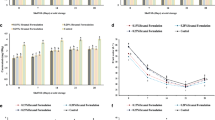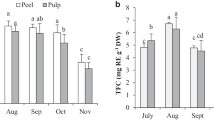Abstract
Globally farmers have difficulty in extending the shelf-life of the tropical fruits due to their perishable nature. The present study aimed to assess the effect of hexanal nano-formulation treatment (NFT) on the shelf-life of Alphonso mango. Further, volatilomics was performed to explore the molecular basis of such effect. Untreated and treated fruits were sampled starting from 5th to 21st day after NFT at an interval of 4 days. Moderate changes in visual and digital colour parameters were evident from the intact and dissected fruits of NFT set compared to untreated fruits. Biochemical assays affirmed the phenotypic differences with significant changes in the colour imparting compounds like carotenoids and anthocyanins among them. Further, gas chromatography–mass spectrometry analysis revealed significant qualitative and quantitative variations in the different classes of compounds like lactones, furanones, esters, aldehydes and alcohols. Some of the key metabolites showed differential modulations among the NFT and untreated fruit sets indicating their potential role in various processes, which ultimately might have resulted in delayed ripening of the mango. Overall, this study has demonstrated the beneficial effect of hexanal and identified important metabolites with the enhanced shelf-life in Alphonso that could be useful for farmers and mango-based food/flavour industries.





Similar content being viewed by others
Data Availability
Not applicable.
Abbreviations
- BHT:
-
Butylated hydroxytoluene
- GC-FID:
-
Gas chromatography-flame ionization detector
- GC–MS:
-
Gas chromatography–mass spectrometry
- HCA:
-
Hierarchical cluster analysis
- HGA:
-
Homogentisate
- HPPD:
-
p-Hydroxyphenyl pyruvate dioxygenase
- NFT:
-
Nano-formulation treatment/treated
- PA:
-
Phosphatidic acid
- PCA:
-
Principal component analysis
- PLD:
-
Phospholipase D
- SD:
-
Standard deviation
- VOCs:
-
Volatile organic compounds
References
Dar, M. S., Oak, P., Chidley, H., Deshpande, A., Giri, A., & Gupta, V. (2016). Nutrient and flavor content of Mango (Mangifera indica L.) cultivars: An appurtenance to the list of staple foods. In M. Simmonds & V. Preedy (Eds.), Nutritional composition of fruit cultivars (pp. 445–467). Switzerland: Elsevier.
Monterocalderon, M., Rojasgrau, M. A., & Martínbelloso, O. (2010). Aroma profile and volatiles odor activity along gold cultivar pineapple flesh. Journal of Food Science, 75, S506–S512.
Negri, A. S., Allegra, D., Simoni, L., Rusconi, F., Tonelli, C., Espen, L., et al. (2015). Comparative analysis of fruit aroma patterns in the domesticated wild strawberries “Profumata di Tortona” (F. moschata) and “Regina delle Valli” (F. vesca). Frontiers in Plant Science, 6, 56.
Ma, X. W., Su, M. Q., Wu, H. X., Zhou, Y. G., & Wang, S. B. (2018). Analysis of the volatile profile of core Chinese mango germplasm by headspace solid-phase microextraction coupled with gas chromatography-mass spectrometry. Molecules, 23, 1480.
Kulkarni, R. S., Chidley, H. G., Pujari, H. G., Giri, A. P., & Gupta, V. S. (2012). Geographic variation in the flavour volatiles of Alphonso mango. Food Chemistry, 130, 58–66.
Pandit, S. S., Kulkarni, R. S., Chidley, H. G., Giri, A. P., Pujari, K. H., Kollner, T. G., et al. (2009). Changes in volatile composition during fruit development and ripening of ‘Alphonso’ mango. Journal of the Science of Food and Agriculture, 89, 2071–2081.
Chidley, H. C., Kulkarni, R. S., Pujari, H. G., Giri, A. P., & Gupta, V. S. (2013). Spatial and temporal changes in the volatile profile of Alphonso mango upon exogenous ethylene treatment. Food Chemistry, 136, 585–594.
Chidley, H. C., Oak, P., Deshpande, A., Pujari, H. G., Giri, A. P., & Gupta, V. S. (2016). Molecular cloning and characterization of O-methyltransferase from Mango fruit (Mangifera indica cv. Alphonso). Molecular Biotechnology, 58, 340–350.
Jincy, M., Djanaguiraman, M., Jeyakumar, P., Subramanian, K. S., Jayasankar, S., & Paliyath, G. (2017). Inhibition of phospholipase D enzyme activity through hexanal leads to delayed mango (Mangifera indica L.) fruit ripening through changes in oxidants and antioxidant enzymes activity. Scientia Horticulturae, 218, 316–325.
Herianus, J. D., Singh, L. Z., & Tan, S. C. (2003). Aroma volatiles production during fruit ripening of Kensington Pride mango. Postharvest Biology and Technology, 27, 323–336.
Deshpande, A. B., Anamika, K., Jha, V., Chidley, H. G., Oak, P., Kadoo, N. Y., et al. (2017). Transcriptional transitions in Alphonso mango (Mangifera indica L.) during fruit development and ripening explain its distinct aroma and shelf life characteristics. Science Report, 7, 8711.
Paliyath, G., & Murr, D. P. (2008). Biochemistry of fruits. Postharvest biology and technology of fruit, vegetables, and flowers (pp. 19–50). Ames: Wiley-Blackwell.
Paliyath, G., Tiwari, K., Yuan, H., & Whitaker, B. D. (2008). Structural deterioration in produce: phospholipase D, membrane deterioration, and senescence. Postharvest biology and technology of fruit, vegetables, and flowers (pp. 195–239). Ames: Wiley-Blackwell.
Paliyath, G., & Subramanian, J. (2008). Phospholipase D inhibition technology for enhancing shelf life and quality. Postharvest biology and technology of fruit, vegetables, and flowers (pp. 240–245). Ames: Wiley-Blackwell.
Foster, D. A., & Xu, L. (2003). Phospholipase D in cell proliferation and cancer. Molecular Cancer Research, 11, 789–800.
Paliyath, G., Pinhero, R. G., Yada, R. Y., & Murr, D. P. (1999). Effect of processing conditions on phospholipase D activity of corn kernel subcellular fractions. Journal of Agriculture and Food Chemistry, 47, 2579–2588.
Kayal, W. E., Paliyath, G., Sullivan, J. A., & Subramanian, J. (2017). Phospholipase D inhibition by hexanal is associated with calcium signal transduction events in raspberry. Horticulture Research, 4, 17042.
Karthika, S., Nanda Kumar, N. B., Gunasekaran, K., & Subramanian, K. S. (2015). Biosafety of nanoemulsion of hexanal to honey bees and natural enemies. Indian Journal of Science and Technology, 8, 30.
Anusuya, P., Nagaraj, R., Janavi, G. J., Subramanian, K. S., Paliyath, G., & Subramanian, J. (2016). Pre-harvest sprays of hexanal formulation for extending retention and shelf-life of mango (Mangifera indica L.) fruits. Scientia Horticulturae, 211, 231–240.
MOACFW. (2012). Annual report of Min. of Agri. Com. & Farmers Welfare, Govt. of India, New Delhi, India. https://agricoop.nic.in/annual-report.
Deshpande, A. B., Chidley, H. G., Oak, P. S., Pujari, K. H., Giri, A. P., & Gupta, V. S. (2016). Data on changes in the fatty acid composition during fruit development and ripening of three mango cultivars (Alphonso, Pairi and Kent) varying in lactone content. Data Brief, 9, 480.
Chang, C. C., Yang, M. H., Wen, H. M., & Chern, J. C. (2002). Estimation of total flavonoid content in propolis by two complementary colorimetric methods. Journal of Food and Drug Analysis, 10, 178–182.
Liu, M., Li, X. Q., Weber, C., Lee, C. Y., Brown, J., & Liu, R. H. (2002). Antioxidant and antiproliferative activities of raspberries. Journal of Agriculture and Food Chemistry, 50, 2926–2930.
Fish, W. W., Perkins-Veazie, P., & Collins, J. K. (2002). A quantitative assay for lycopene that utilizes reduced volumes of organic solvents. Journal of Food Composition and Analysis, 15, 309–317.
Landau, S., & Rabe-Hesketh, S. (1999). StatView for windows, version 5.0. Statistical Methods in Medical Research, 8, 337–341.
Chong, J., Soufan, O., Li, C., Caraus, I., Li, S., Bourque, G., et al. (2018). MetaboAnalyst 4.0: Towards more transparent and integrative metabolomics analysis. Nucleic Acids Research, 46, W486–494.
Prescott, A. G., & John, P. (1996). Dioxygenases: Molecular structure and role in plant metabolism. Annual Review of Plant Biology, 47, 245–271.
Norris, S. R., Shen, X., & Della, P. D. (1998). Complementation of the Arabidopsis pds1 mutation with the gene encoding p-hydroxyphenylpyruvate dioxygenase. Plant Physiology, 117, 1317–1323.
John, J., Subbarayan, C., & Cama, H. (2006). Carotenoids in three stages of ripening of mango. Journal of Food Science, 35, 262–265.
Maldonado-Celis, M. E., Yahia, E. M., Bedoya, R., Landázuri, P., Loango, N., Aguillón, J., et al. (2019). Chemical composition of Mango (Mangifera indica L.) fruit: Nutritional and phytochemical compounds. Frontiers in Plant Science, 10, 1073.
Yashoda, H. M., Prabha, T. N., & Tharanathan, R. N. (2005). Mango ripening-chemical and structural characterization of pectic and hemicellulosic polysaccharides. Carbohydrate Research, 340, 1335–1342.
Pandit, S. S., Chidley, H. G., Kulkarni, R. S., Pujari, K. H., Giri, A. P., & Gupta, V. S. (2009). Cultivar relationships in mango based on fruit volatile profiles. Food Chemistry, 114, 363–372.
Li, L., Ma, X. W., Zhan, R. L., Wu, H. X., Yao, Q. S., Xu, W. T., et al. (2017). Profiling of volatile fragrant components in a mini-core collection of mango germplasms from seven countries. PLoS ONE, 12(12), e0187487.
Lopez-Cobo, A., Martín-García, B., Segura-Carretero, A., Fernández-Gutiérrez, A., & Gómez-Caravaca, A. M. (2017). Comparison of two stationary phases for the determination of phytosterols and tocopherols in mango and its by-products by GC-QTOF-MS. International Journal of Molecular Sciences, 18, 1594.
Pagadala Damodaram, K. J., Aurade, R. M., Kempraj, V., Roy, T. K., Shivashankara, K. S., & Verghese, A. (2015). Salicylic acid induces changes in mango fruit that affect oviposition behavior and development of the oriental fruit fly Bactrocera dorsalis. PLoS ONE, 10(9), e0139124.
Syeda, F. A., Habib-ur-Rahman, Choudahry, M. I., & Atta-ur-Rahman. (2011). Gas chromatography-mass spectrometry (GC-MS) analysis of petroleum ether extract (oil) and bio-assays of crude extract of Iris germanica. International Journal of Genetics and Molecular Biology, 3, 95–100.
Bender, R. J., Brecht, J. K., Sargent, S. A., & Huber, D. J. (2000). Mango tolerance to reduced oxygen levels in controlled atmosphere storage. Journal of the American Society for Horticultural Sciences, 125(6), 707–713.
Acknowledgements
MSD acknowledges Council of Scientific and Industrial Research (CSIR, New Delhi, India) for the fellowship of JRF & SRF, and the Academy of Scientific and Innovative Research (AcSIR), India, for enrolment in the Ph.D. programme. Authors thank Mr. Shounak Jagdale (CSIR-NCL) for the help during data analysis.
Funding
APG and VSG are thankful to the funding agency, CSIR, for the research under project CSC0133 (FUNHEALTH) to CSIR-NCL. KSS thanks the Global Affairs Canada and International Development Research Center, Canada, for funding the project "Enhanced Preservation of Fruits using Nanotechnology" at TNAU, Coimbatore.
Author information
Authors and Affiliations
Contributions
APG, BBD and KSS conceived the idea. MSD, BBD, VSG and APG planned the work, while HS, JS and KSS collected and treated the mango samples with hexanal nano-formulation. MSD and BBD carefully arranged, harvested and extracted all the fruit samples as per the stages. MSD carried out all the experiments post--nano-formulation treatment and analysed the data with inputs from BBD and APG. MSD prepared the figures and tables with the help from BBD and APG. Subsequently MSD and BBD wrote the initial draft. All the authors contributed in editing the manuscript and approved the final manuscript.
Corresponding authors
Ethics declarations
Conflict of interest
The authors declare that they have no conflicts of interest
Ethical Approval
Not applicable.
Consent to Participate
Not applicable.
Consent for Publication
Not applicable.
Additional information
Publisher's Note
Springer Nature remains neutral with regard to jurisdictional claims in published maps and institutional affiliations.
Electronic supplementary material
Below is the link to the electronic supplementary material.
Rights and permissions
About this article
Cite this article
Dar, M.S., Dholakia, B.B., Shanmugam, H. et al. Differential Modulation in Metabolites Revealed with the Improvement in the Shelf-Life of Alphonso Fruits. Mol Biotechnol 62, 508–520 (2020). https://doi.org/10.1007/s12033-020-00267-7
Accepted:
Published:
Issue Date:
DOI: https://doi.org/10.1007/s12033-020-00267-7




